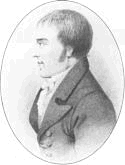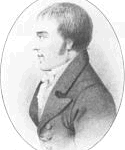The Life & Works of Robert Tannahill by Claire Casey
 For the vast majority of people throughout the world, Scotland’s literary tradition can be summed up by writers like Robert Burns and Sir Walter Scott. As so often the case with Scotland, there is a lot more to the country’s literary endeavours than meets the eye. One of the country’s most talented poets and lyricist was a young weaver from Paisley whose life ended in tragic circumstances. Robert Tannahill, who is also known as the Weaver Poet, was born in 1774 into a family of weavers.
For the vast majority of people throughout the world, Scotland’s literary tradition can be summed up by writers like Robert Burns and Sir Walter Scott. As so often the case with Scotland, there is a lot more to the country’s literary endeavours than meets the eye. One of the country’s most talented poets and lyricist was a young weaver from Paisley whose life ended in tragic circumstances. Robert Tannahill, who is also known as the Weaver Poet, was born in 1774 into a family of weavers.
Even though he lived and worked in England for a short period of time, he spent the vast majority of his life living and working in Paisley.
Despite the fact that he continued to work as a weaver, it was known that Tannahill managed to make himself a little writing desk that he attached to the side of his loom. This was to allow he to continue writing his songs lyrics and poems even while he was busy working in the trade that made Paisley famous the world over.
In spite of his obvious literary talent, Tannahill was a quiet and unassuming character, who seemed to have been awkward in the company of women, or around people he didn’t know. It has been argued that this shyness was due to the fact that he was born with a slight deformity to his right leg and foot. This seemed to have taken the form of his right leg slightly shorter than his left, with his right foot being slightly twisted.
In spite of this, Tannahill was known to have been something of an avid walker, and he would regularly explore the countryside that surrounds Paisley. One of his favourite haunts was the Gleniffer Braes, which can be found just on the southern reaches of the town. Much of what Tannahill saw on one of his many walks went on to influence and inspire many of his poems and songs. These songs include The Braes O’ Gleniffer and Gloomy Winters No Awa’.
The same landscape that became one of Robert Tannahill regular haunts can still be explored today. Much of the area has been protected through the setting up of the Gleniffer Braes Country Park. The area is just as breathtaking as it was in day of Tannahill. Visitors are treated to views across Paisley and Glasgow, and on a clear day, you will even be able to see as far north as Ben Lomond and the Trossachs. There are also a number of hidden gems that can be found throughout the park. Despite the passage of time, it is still clear to see why Tannahill was influenced by the landscape that he found in the Braes.
Even though Tannahill wrote numerous poems and songs that dealt with the world that he saw around him, he tended to avoid writing about local or national politics. Despite this, it has been argued that the themes of his poems still had much in common with those of Robert Burns, who is well known for using his writing to make political comments. The themes that can be found in the work of both Burns and Tannahill include the common man, love and brotherhood, even though the form of Tannahill’s poems do differ from those of Burns in their style.
In 1807, Tannahill managed to get a collection of his poems published, primarily with the aid of subscriptions. This first collection of poems proved to be a great success. Because of the popularity of his first collection, Tannahill made a decision that would have tragic consequences. In 1810, he had decided that he would submit a new collection of poems directly to a publisher, this time without gaining any subscriptions beforehand.
It seems to be that Tannahill had believed that with the success of his previous collection, that a publisher would have enough incentive to publish his new collection of poems without insisting on the use of subscriptions. But for a reason that has since been lost to history, the collection was rejected. At the time that he was trying to get his second collection of poems published, Tannahill’s friends were becoming increasingly worried about his state of mind and feared leaving him alone for too long. On many occasions, they would insist on walking him home, just to make sure that he arrived safely.
Despite his friends’ best efforts, on the night of the 17th May 1810, Robert Tannahill managed to slip out of his family’s cottage without being noticed. It was soon discovered that he was missing and a search of the area was quickly organised by his friends and family. The whereabouts of the young poet where soon discovered, but it was already too late. Tannahill had committed suicide by drowning himself in the canal close to his cottage. He was laid to rest in the graveyard of the nearby Castlehead Kirk, where his grave can still be found to this day.
Even though Tannahill has yet to gain the level of fame or recognition that has been enjoyed by the likes Robert Burns, the fact that all of Tannahill’s work is still in print today highlights the fact that there is still a demand for his poems and songs. His work is also being performed on a regular basis, especially by groups like the Tannahill Weavers, who have taken Tannahill’s work all over Scotland and the world.
Memorials to Paisley’s Weaver Poet can also be found throughout the town. These include the statue of Tannahill that can be found standing close to the Gauze Street entrance of the Abbey Close. There is also the Tannahill Well and the Tannahill Walk, both of which can be found in the Gleniffer Braes Country Park, both fitting tributes in one of the poet’s favourite haunts. The cottage in which he was born and where he spent most of his life can still be found on Paisley’s Queen Street.
The cottage has become a regular stop on the tours that are regularly lead by the Robert Tannahill Federation. This is an organisation that aims to promote the life and works of Paisley’s Weaver Poet. An exhibition on Tannahill and his connection to the Gleniffer Braes has also been organised for Paisley’s Museum and Art Gallery, which will be running from the 27th May until the 21st August, 2011.
Even though more than 200 years have passed since his tragic death, Tannahill still has his admirers and champions, and he is yet to be forgotten by his fellow Buddies .
People from Paisley are known as Paisley Buddies, or just Buddies for short.
All information was supplied to Paisley on the web by Claire Casey.


